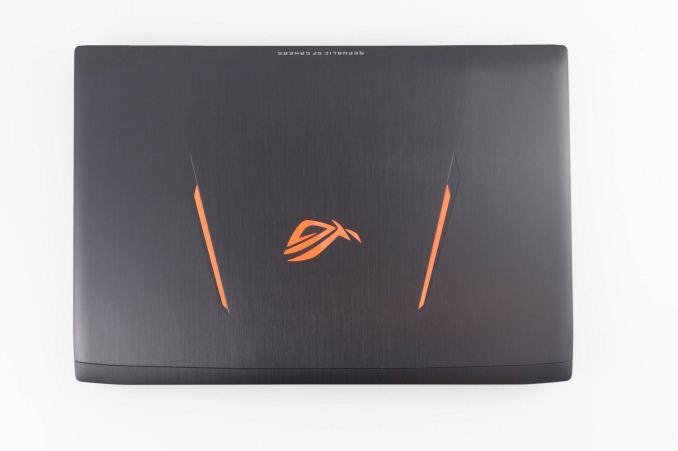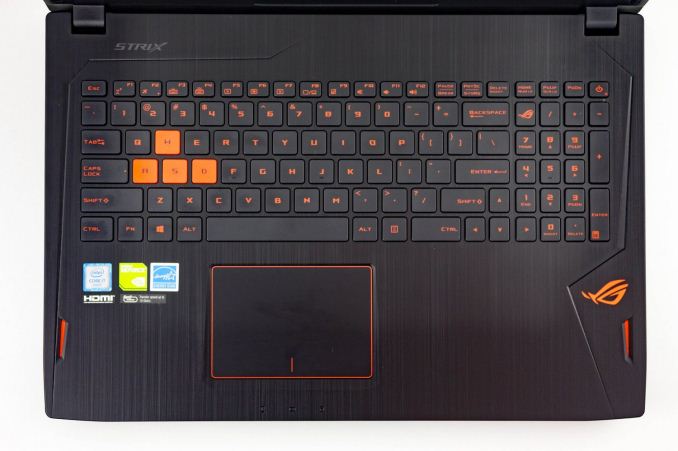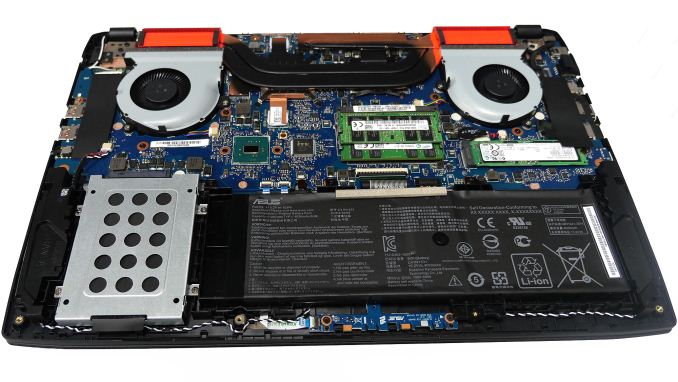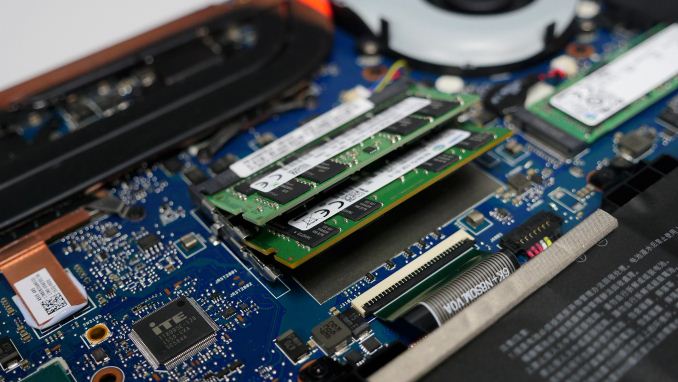The ASUS ROG Strix GL502VS Review: Mainstream GTX 1070 with G-SYNC
by Brett Howse on December 9, 2016 8:00 AM ESTDesign
Without putting too fine a point on it, ASUS can design some stunning notebooks, but this is not one of them. Stepping down to their value line keeps the same powerful internals, but to hit this price point ASUS has taken some liberties with the chassis design. The entire notebook is built from a fairly low quality plastic, with the exception of the lid which has a metal top. The top has a brushed finish with lines running parallel down the entire device, which looks nice, but that’s where the premium materials end.
Opening the notebook, the same brushed finish is replicated on the plastic keyboard deck, but this time on the plastic finish. The keyboard itself features 1.6 mm of travel with red backlighting, but the keyboard feel lacks the nice feel of some of the other ASUS notebooks. The WASD keys are red with black fonts, compared to the rest of the keys which are black with red fonts, and although the look won’t appeal to everyone, it does help quickly identify the most needed keys for gaming. ASUS continues its silly tradition of having the power key right in the keyboard, with it at the top right. If you accidently go to press the minus key, you may end up shutting off the laptop. There’s no good reason for them to put it there, although at least on this notebook, with its extra number pad, it is less likely to get hit than on one of their smaller notebooks where it is right beside the delete key. This seems like a small gripe, but shutting off your computer when going to hit a key is not a great experience.
The trackpad on this notebook does feature the Microsoft Precision Touchpad drivers, for better or for worse, and it’s nice to see Microsoft reigning this in. They still have some work to do with the drivers, but at least it is a consistent experience across devices now. That being said, the trackpad on this notebook is not quite as smooth as some other notebooks, and picks up fingerprints quite readily. It would be nice to see a glass trackpad, although once again the budget comes into play. Luckily a good mouse is going to be required for gaming regardless, so this isn’t as big of an issue as it is on a more portable device.
Being a large gaming laptop, there is expandability with the GL502VS, and just a couple of screws will let you pop off the bottom and access the memory, which has two SODIMM slots, the M.2 SSD, and the SATA drive. Maximum memory is 32 GB through two 16 GB DDR4 modules. On our 16GB sample, only one memory slot was occupied for single channel memory performance.
Interior photos courtesy of rog.asus.com
Overall the design of the ASUS GL502VS is kind of disappointing. The top of the notebook is a very nice looking metal, but the remainder of the notebook is a fairly low grade plastic. ASUS does build some nice notebooks, but to hit their budget on this one with the components on the inside, clearly some cost cutting was necessary. They have also gone a bit overboard with the red accents on this notebook, and especially with the bright shade of red chosen, although the almost orange WASD keys do look nice and red with the keyboard backlighting on.

















54 Comments
View All Comments
milkod2001 - Friday, December 9, 2016 - link
$1600 is not mainstream by all means but it has very decent specs that that price. It should last at least 3 years no probs. The only thing i would want to change is screen size, should have been 17''.Brett Howse - Sunday, December 11, 2016 - link
They do sell the GL702VM as a 17.3-inch model, but only with GTX 1060. ASUS has the GTX 1070 and up in the G752 which is a nice machine.BrokenCrayons - Friday, December 9, 2016 - link
Mainstream is different for everyone, but I agree that even on the low-end of its price spectrum that this laptop is absolutely not mainstream. However, I understand when you're a writer you're compelled to throw something out there that ultimately can end up the subject of unforseen debate. Let's try not to get overly hung up on it since, really, its as unimportant as calling a penguin a fish. The only thing that's changed is the label. Nothing fundamental about the squishy inside bits of the penguin are made different in doing so.SharpHawk - Friday, December 9, 2016 - link
No thermal data on the CPU?shelbystripes - Friday, December 9, 2016 - link
I got the GL502VM on sale from Amazon for a ridiculous $899 on Black Friday. At that price it's an utterly amazing system, and even at regular price is one of the cheapest Nvidia 10-series systems around, though I have some comments about its performance that this article fails to mention. The article makes it seem like it's just a GL502VS with a 1060 instead of a 1070, and that's not the case:1) The GL502VM doesn't come with G-Sync. At least, the lower end models don't.
2) The base model uses a quad-core i5, which is slightly slower, but more importantly lacks hyperthreading. I've found HT to historically not make a huge difference, but it's worth noting.
2) The GL502VM comes with 8GB RAM soldered on. It has one SODIMM slot, so if you buy a 16GB model it includes one 8GB DIMM plus the soldered-on RAM. Max memory capacity is limited to 24GB, since you can't swap out one channel of 8GB for 16GB later.
3) The GTX 1060 inside is the 3GB model, which actually has not just less RAM but fewer cores than the 6GB model. Still sufficient for 1080p gaming in a lot of games, especially for a budget gaming laptop, but worth noting it's about more than just the RAM. (I'm not sure if there's a similar discrepancy between the 4GB and 8GB GTX 1070 models available in the GL502VS, but at least you can get the higher end model there.)
4) This is really a comment on both machines, but the base models come with a mechanical HDD only. There's still an M.2 slot in the base models, it's just unpopulated. Still, I snagged a cheap 2.5" SATA SSD on Black Friday, and just a little simple surgery (not difficult, but 10 screws just to open it up, plus 8 screws for the HDD mount!) later, I had a MUCH faster system than I would have otherwise.
And lastly, a general tip when self-upgrading to save money: Windows 10 doesn't come with activation keys, it syncs your system unique ID to your Microsoft account. Microsoft made clean-installing Windows 10 much easier, you can download a tool from Microsoft's website to make a Windows 10 USB installer, but you'll need to boot the system at least once on the mechanical HDD to activate the copy of Windows 10 it comes with and link it to your Microsoft account. Then you can yank the HDD, swap in an SSD, and do a clean install (even if you're adding an M.2 SSD and keeping the HDD, you may want to do a clean install onto the SSD to get rid of the crapware anyway) without any problem. Just log into your Microsoft account during the reinstall and it'll recognize you have a Windows 10 license for that device. If (like me) you were clinging to Windows 7 on your last machine, I figure this knowledge might be new and useful to you.
sundragon - Friday, December 23, 2016 - link
Thank you! I may do this on my 502VS.label47 - Friday, December 9, 2016 - link
If you play heavy games the Battery will drain while plugged in...https://rog.asus.com/forum/showthread.php?88742-GL...
jsntech - Friday, December 9, 2016 - link
Yikes. Wonder what happens when it gets down to 0%? The ASUS rep responding to one of the bunches of people with the same complaint is unfortunate: " I've PM you a message, please check your inbox, thank you". Like they're trying to run interference instead of just openly acknowledging and working with customers. "Support" like that is one of the reasons I am hesitant to go with ASUS and others like them (though the bigger players are no better...sigh).kvnobrien - Friday, December 9, 2016 - link
"ASUS would have much better battery life if it just had a bigger battery" - quote of the year. Thank you this made me chuckle. I get the point you were trying to make it's just funny though.marco89nish - Friday, December 9, 2016 - link
I fail to see usefulness of G-Sync on 60Hz 1080p display with GTX 1070. It should be very challenging to drop 1070 to under 60 fps in next few years. Adding 75/90/120Hz display instead of G-Sync would yield much better value in my opinion.